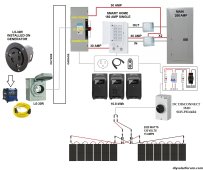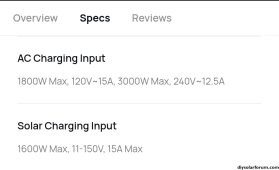EcoFlow Delta Pro Specs Limits:
150v 15a 1600w
You can't go over 150v
You can go over 15a as the unit will not use anymore then 15a
Watts?
Can I go over on Wattage? I know amperage is no problem and my voltage is within the limits.
If I add my last 2 solar panels and knowing the amperage is cut off at 15 amps and my voltage is 135.6v x 15A = 2034 watts
I've spent the last few weeks reading everything I could on this forum and must say I've learned a lot of great information.
Something I don't see and why I had came to the forum in the first place and have yet to find the answer even after emailing EcoFlow.
What I have learned is your solar input can't go over 150v and the amps are cut off at 15 amps.
At the moment I am holding off to hook up my last 2 solar panels until I have a firm answer to my question.
I read a lot of warnings not to go over the voltage and the amperage doesn't matter, but don't see anything about the wattage. I've tried emailing EcoFlow a few times about this but not really getting a direct answer beside what the manual says which doesn't say anything about the amperage.
At the moment am at 113v x 15a = 1695 watts with the hopes its safe to use the other 2 panels to push up my input wattage.
End Goal: 135.6v x 15a = 2034 watts
Here is my setup am hoping I can go with 12 panels, at the moment I have 10 panels installed.
150v 15a 1600w
You can't go over 150v
You can go over 15a as the unit will not use anymore then 15a
Watts?
Can I go over on Wattage? I know amperage is no problem and my voltage is within the limits.
If I add my last 2 solar panels and knowing the amperage is cut off at 15 amps and my voltage is 135.6v x 15A = 2034 watts
I've spent the last few weeks reading everything I could on this forum and must say I've learned a lot of great information.
Something I don't see and why I had came to the forum in the first place and have yet to find the answer even after emailing EcoFlow.
What I have learned is your solar input can't go over 150v and the amps are cut off at 15 amps.
At the moment I am holding off to hook up my last 2 solar panels until I have a firm answer to my question.
I read a lot of warnings not to go over the voltage and the amperage doesn't matter, but don't see anything about the wattage. I've tried emailing EcoFlow a few times about this but not really getting a direct answer beside what the manual says which doesn't say anything about the amperage.
At the moment am at 113v x 15a = 1695 watts with the hopes its safe to use the other 2 panels to push up my input wattage.
End Goal: 135.6v x 15a = 2034 watts
Here is my setup am hoping I can go with 12 panels, at the moment I have 10 panels installed.
Attachments
Last edited:




